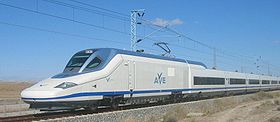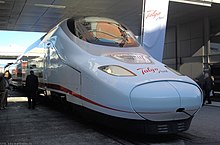Talgo
 | |
| Company type | Private company |
|---|---|
| ISIN | ES0105065009 |
| Industry | Rail vehicle manufacturing |
| Headquarters | Las Rozas de Madrid, Spain[1] |
| Products | Locomotives High-speed trains Intercity and commuter trains |
Number of employees | 1,100 (Spain) |
| Website | talgo.com |
Talgo is a Spanish manufacturer of intercity standard and high speed passenger trains.
Corporate history
TALGO (Tren Articulado Ligero Goicoechea Oriol, Goicoechea-Oriol light articulated train), Alejandro Goicoechea and José Luis Oriol being the founders of the company.
Talgo Patents S.A. was first incorporated in 1942.
In March 2007 Talgo sold its Finnish rolling stock manufacturing subsidiary Talgo Oy to its local management and other Finnish investors. The company, which Talgo had owned for only seven years, reverted to its previous name of Transtech Oy. The company spends 10 to 12 percent of revenues on research and development,[2] but the main revenue source is the Spanish railway operator Renfe.[3]
Design

Talgo trains are best known for their unconventional articulated railway passenger car that uses a type similar to the Jacobs bogie that Talgo patented in 1941. The wheels are mounted in pairs but not joined by an axle and the bogies are shared between coaches rather than underneath individual coaches. This allows a railway car to take a turn at higher speed with less swaying. As the coaches are not mounted directly onto wheel bogies, the coaches are more easily insulated from track noise. Talgo trains fitted with variable gauge axles can change rail gauge - for instance at the Spanish (1668 millimeters)/French (1435 millimeters) border interchange.
Since the introduction of the Talgo Pendular in 1980, the train tilts naturally inwards on curves, allowing it to run faster on curves without causing discomfort to passengers. The carriage tilting system pivots around the top of the suspension columns, which has the effect of partially cancelling out the effects of the lateral acceleration when cornering.
Trains
Talgo trains are divided into a number of generations. They come in both locomotive hauled and self-propelled versions.


Talgo I
The Talgo I was built in 1942 in Spain. The coaches were built at the "Hijos de Juan Garay Fábrica" in Oñati and the locomotive was built at the workshops of the "Compañia de Norte" in Valladolid.[4] It was built as a prototype, and it was used to set several railroad speed records.[2]
Talgo II
Talgo II coaches and locomotives were first built in 1950 at the American Car and Foundry Company (ACF) works in the United States under the direction of Spanish engineers, and entered service on the Rock Island Line, servicing the Jet Rocket train, between Chicago and Peoria, Illinois. One was also trialed on the New York Central Railroad until 1958 but saw little success.[2] Talgos were also built for the New York, New Haven and Hartford Railroad for its "John Quincy Adams" train from (New York City to Boston, Massachusetts), and the Boston and Maine Railroad for its "Speed Merchant" train, running between (Boston, Massachusetts and Portland, Maine).[5] Soon afterwards, Talgo II trains began running in Spain, and were successfully operated until 1972.[4]

Talgo III
Talgo III coaches and locomotives entered service in 1964, introducing longer cars and easy directional reversibility of the cars. The Talgo III/RD was equipped with variable gauge axles, and this permitted the introduction, on 1 June 1969, of the first through train between Madrid and Paris (the new service being designated Puerta del Sol), as well as between Barcelona and Geneva (the Catalan Talgo), despite the difference in rail gauge.[2][6] The same equipment was used for the Barcelona Talgo, which began operation on 26 May 1974 as the first-ever through train service between Barcelona and Paris.[7]

Talgo Pendular
The Talgo Pendular (Talgo IV and Talgo V, also VI & Talgo 200 or 6th generation), introduced in 1980, created the "natural tilting" train, using a passive system that tilts the carriages with no need for electronic sensors or hydraulic equipment.[3] The wheels are mounted on monoaxles between the carriages, and sitting on top of the monoaxles are suspension columns. The carriages are attached to the top of the suspension columns and swing outwards as the train goes through a curve.
In 1988, a Talgo Pendular was used on trials for Amtrak on the Boston-New York corridor in the United States and on Deutsche Bahn lines in Germany.[4] Trial commercial services with Talgo cars in the US commenced in 1994 between Seattle and Portland, and from 1998 different trains have been used on the Amtrak Cascades services from Vancouver, British Columbia south to Seattle, Washington, continuing south via Portland, Oregon to Eugene, Oregon.[8]

Talgo 200 series trains are also in use in Kazakhstan for the overnight train Almaty–Astana.[9]
Talgo VII
The Talgo VII introduced beginning in 2000 is used as a locomotive-pulled train set as well as intermediate cars for the multiple units Talgo 250, Talgo 350 and Talgo XXI. The carriages are similar to the Talgo Pendular type but have an air-controlled hydraulic brake system and power supply from head end power instead of diesel engine-generators in the end cars. Talgo VII trains have cars with two pairs of wheels in the middle rather than at one end.[10]
Talgo 8
The Series 8 passenger cars are similar to the Series VII cars, but are designed for the North American market. Talgo made an agreement in 2009 to build a manufacturing facility in Wisconsin which would initially supply two 14-car trainsets for the Amtrak Hiawatha Service. The company expressed hope the plant would later be used to build trains for other U.S. rail projects.[11][12]
Early in 2010, the Oregon Department of Transportation announced that it had negotiated the purchase of two 13-car trainsets for use in the Pacific Northwest rail corridor between Eugene and Vancouver, British Columbia.[13] These trainsets were also manufactured in Wisconsin, and were delivered in 2013. The sets are currently undergoing testing on the "Cascades" corridor in the Pacific Northwest and, upon acceptance, will join the five existing sets in regular service.
Talgo 250
The Talgo 250 is a dual voltage electric train (AC/DC) equipped with variable gauge axles. This allows the units to be used on high-speed lines and on conventional broad gauge lines. A Talgo 250 train consists of two power cars and 11 Talgo VII intermediate coaches. This class was developed for RENFE (classed as S-130).[14]
The Uzbekistan Railways ordered two Talgo 250 sets of a Russian gauge version in 2009. The first set arrived at Tashkent in July 2011.[15]

Talgo 250 Hybrid
The Talgo 250 Hybrid is a dual-voltage dual-power train equipped with variable gauge axles. The train is therefore also able to operate on non-electrified lines. A Talgo 250 Hybrid train consists of two power cars, two technical end coaches and nine Talgo VII intermediate coaches. The trains were developed for RENFE and classed initially as S-130H, later as S-730). They are rebuilt from existing Talgo 250 trains.[16]
Talgo 350
The Talgo 350 entered service as the RENFE AVE Class 102 marking the company's entry into the high-speed train manufacturing market. Tests with the prototype commenced in 1994,[4] and Talgo 350 trains have been operating at a top commercial speed of 330 km/h on the Madrid-Barcelona and Madrid-Valladolid lines since 22 December 2007. This series of trains is designed to reach a speed of 350 km/h (220 mph), although present lines and commercial services limit the speed to 330 km/h (205 mph).[17][18] The train consists of two power cars and Talgo VII intermediate cars with improved brakes and additional primary suspension.[10]

Talgo XXI
Talgo XXI is a project for a high speed diesel-powered train, that operates in push-pull with one or two power cars and Talgo VII intermediate cars. The North American version has four-axle power cars in compliance with United States FRA regulations. Only one train in compliance with European UIC standards has been built to date.[19] Talgo reported that the Talgo XXI attained 256 km/h on the Olmedo-Medina del Campo high speed experimental line on 9 July 2002,[20] which led to a claim for the world speed record for a diesel train. After the test runs the train was sold to the Spanish infrastructure authority ADIF as a measuring train for high speed lines.
Talgo AVRIL

Talgo is developing a train that is currently in the concept stage, known as "AVRIL" (Alta Velocidad Rueda Independiente Ligero - Light High-Speed Independent Wheel), intended for speeds of 380 km/h.[21] The system will use underfloor traction in the front and rear vehicles, with the intermediate carriages having the Talgo Pendular system (which cannot use motored axles on the axles corresponding to the system).
Variable Gauge Axles (VGA)
In addition to the multiple units with Variable Gauge Axles, Talgo built in 2005 a prototype of a VGA locomotive (the L-9202, TRAV-CA, 130-901 or Virgen del Buen Camino[22][23]).
See also
|
|
References
- ^ Information about Talgo
- ^ a b c d Mauro F. Guillén (2001). The Limits of Convergence. Princeton University Press. ISBN 0-691-05705-2. Retrieved 7 May 2008.
- ^ a b Mauro F. Guillén (2005). The Rise of Spanish Multinationals. Cambridge University Press. Retrieved 7 May 2008.
- ^ a b c d "Historia de Talgo". www.talgo.com. Retrieved 15 June 2010.
- ^ Kirkland, John F. (1985). The Diesel Builders Volume 1: Fairbanks-Morse and Lima-Hamilton. Interurban Press. ISBN 0-916374-69-6.
{{cite book}}: Unknown parameter|month=ignored (help) - ^ "Stop Press" (changes taking effect). Cooks Continental Timetable (June 1969 edition), p. 6; also pp. 71, 106. London: Thomas Cook Publishing.
- ^ "Barcelona Talgo". Thomas Cook Continental Timetable (June 1975 edition), p. 466. Thomas Cook Publishing.
- ^ "TALGO AMERICA - History". www.talgoamerica.com. Archived from the original on 25 June 2008. Retrieved 7 May 2008.
- ^ [1] Kazakhstan Buys Two Talgo Trains, International Railway Journal (1 December 2000)
- ^ a b "Talgo 7". Christian Torrego, 2002-2003 (Translation by P.L. Guillemin, April 2003). Retrieved 29 December 2008.
- ^ "Wisconsin wants Talgo trains". Railway Gazette International. 21 July 2009. Retrieved 15 December 2009.
- ^ "History: North American Milestones". Talgo America. Retrieved 15 December 2009.
- ^ "ODOT purchases passenger trains". Retrieved 28 February 2010.
- ^ "Productos Talgo". www.talgo.com. Archived from the original on 18 April 2008. Retrieved 7 May 2008.
- ^ "Uzbekistan_Temir_Yollari_Talgo_250" in Ferropedia.es
- ^ "Talgo 250" (PDF). www.talgo.com. Retrieved 28 August 2011.
- ^ "Railway Technology - Spain's Great Rail Race - High-Speed Train Lines". www.railway-technology.com. Retrieved 7 May 2008.
- ^ [2] Talgo evolves its unique design for ultra high speed - High Speed: Spain, International Railway Journal, 1 October 2002
- ^ "TALGO AMERICA - Talgo XXI". www.talgoamerica.com. Archived from the original on 24 June 2008. Retrieved 7 May 2008.
- ^ "Talgo: History". www.talgo.com. Archived from the original on 18 April 2008. Retrieved 2 June 2008.
- ^ "Talgo's 380 km/h Avril train to take on the airlines". Railway Gazette International. 27 July 2009.
- ^ TRAVCA article in Ferropedia.es
- ^ http://www.crashbuffer.com/p14e.htm
